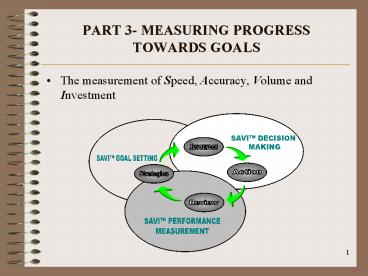PART 3 MEASURING PROGRESS TOWARDS GOALS - PowerPoint PPT Presentation
1 / 24
Title:
PART 3 MEASURING PROGRESS TOWARDS GOALS
Description:
Show evidence as to the performance gaps in areas where strategic outcomes are not being met ... performance information in an accurate and timely fashion. ... – PowerPoint PPT presentation
Number of Views:65
Avg rating:3.0/5.0
Title: PART 3 MEASURING PROGRESS TOWARDS GOALS
1
PART 3- MEASURING PROGRESS TOWARDS GOALS
- The measurement of Speed, Accuracy, Volume and
Investment
2
Introduction
- Performance measurement is the most neglected and
yet critically important element of the
management cycle. - Now in section 3, we will do two things, we will
learn how to measure progress, and we will learn
how to motivate progress. - Measuring progress is a scientific model of
capturing change in performance areas that are
desirable.
3
CHAPTER 10, PERFORMANCE MEASUREMENT AND
PERFORMANCE MANAGEMENT
- Things could be worse, suppose your errors were
counted and recorded every day like a baseball
player
4
Introduction to Chapter 10
- Figure 10.1, The Management Cycle
5
LINKING PERFORMANCE MEASUREMENT TO STRATEGIC PLANS
- WHY IS MEASUREMENT NECESSARY?
- To show progress towards achieving strategic
goals. - Show evidence as to the performance gaps in areas
where strategic outcomes are not being met - Show evidence to let superior performance be
recognized and rewarded. - Show evidence to let poor performance be
recognized and corrected.
6
AN OVERVIEW OF PERFORMANCE MANAGEMENT
- Figure 10.2, levels of performance management
Strategic vision
Directors View
Management View
Core Strategies
FEEDBACK
Operations View
Action Plans
Satisfaction
7
Figure 10.3, An Overview Of Performance
Measurement
8
Building a Measurement System
- The first effort in performance measurement will
be to develop measures of results and outcomes - we can then translate the strategic goal into an
operating goal,
9
Building a Measurement System
- two principal dimensions.
- We need to measure activity
- Hour spent, materials consumed, overhead used.
- We need to measure results and outcomes.
- Things built, customers satisfied, money made
10
- Figure 10.4,
- Input and Output Measures
11
Figure 10.5, Example Output Measures
12
Figure 10.6, Example Input Measures
13
Two Kinds of Data
- Measures that come from observations of events
are called Counting measures, - Measures of opinion are called Judgement
measures.
14
Developing SAVI measures
- Regardless of whether you are developing input or
results measures, and regardless of whether you
are developing high level measures for directors
or operating level measures..there is one
framework for the development of the performance
measures.
15
Figure 10.7, Four Dimensions of Measurement
Do what you do at the right speed. Speed means
on time, not fast!
Speed
tm
Do what you do with accuracy. This is the quality
dimension of your work
Accuracy
Do what you do in the right volume. You need to
meet the needs of all of your customers.
Volume
Soundly manage investment in resources, in terms
of efficient and effective allocation of money,
assets and people.
Investment
16
Four Dimensions of Measurement
- Speed
- Speed, an output measure, refers to the timing of
the delivery of the product or service, not
necessarily how fast.. - Accuracy
- Accuracy, an output measure, is the quality
dimension of your results. - Volume
- Volume, an output measure, refers to the quantity
of goods and services provided. - Investment
- Investment, an input measure, refers to the
efficient utilization of total organizational
resources to get the job done.
17
The Bus Ride.
- Riders on a bus will be happy when the bus
arrives on time S, it is clean and the driver is
safe A, everyone at the bus stop is picked up V,
and the fare is fair I. If any one of the
dimensions is out of line, satisfaction declines.
18
The Budget Process.
- Internal customers, senior management, will be
happy when the deadline is met S, the budgets are
accurate A, all divisions have prepared the
budget V, and there was a minimum investment made
I in preparing the budget because the process was
simple.
19
The Restaurant.
- Customers will be happy when the service is
prompt S, (fast at the drive through, slow at the
romantic restaurant), the food is good quality A,
the portion was the right size V and the price
was fair I.
20
The Grocery Store.
- Customers are happy when the store is open at
convenient times S, the goods are fresh A, there
is enough selection of products V and prices are
low I.
21
The Car Dealership.
- Customers are happy when the model they want is
available immediately S, it is clean on delivery
A, it is reliable for the first five years V, and
the price was fair I.
22
Chapter Summary
- In order to effectively manage performance we
need to have good measures of performance. To
have good measures we need the commitment of the
organization to make improving performance a high
priority, and a safe thing to do.
23
Good performance measures should be
- Measurable
- The data management system must be able to locate
and report performance information in an accurate
and timely fashion. - Observable
- There is a cause and effect relationship between
data reported and desired performance such that
when the data shows improvement, performance has
actually improved. - Reliable
- The goal and its measurement system should offer
consistent and uniform reporting. - Controllable
- The variables that cause change in a performance
area must be in the manager's control. - Active
- The goal must relate to an active business
process that is in the realm of the manager's
routine.
24
Closing Remarks
- This chapter introduced the concepts of
measurement, chapter 11 will present performance
measurement examples in detail (this should make
us able to do it), and chapter 12 will cover
the human side of measuring and managing
performance, (this should make us willing to do
it).































